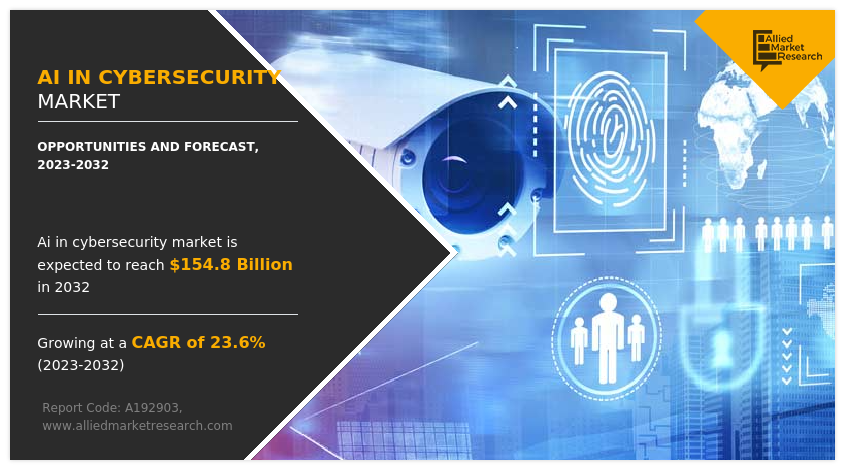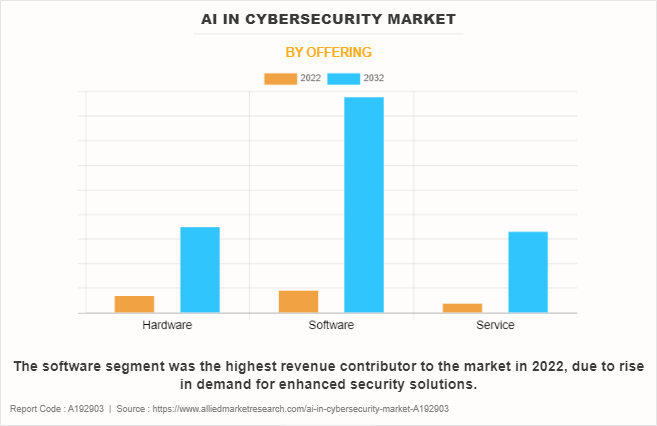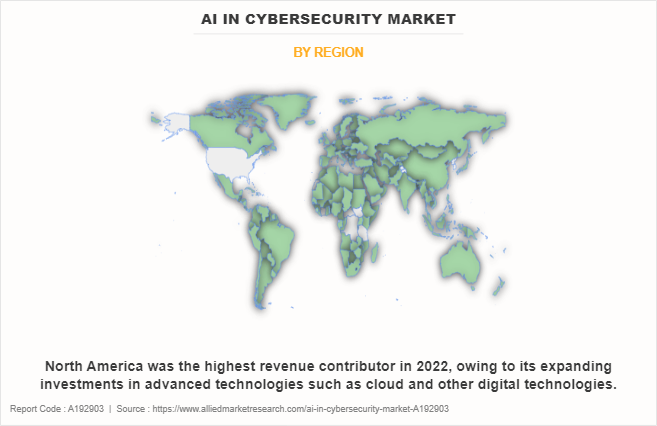AI in Cybersecurity Market Statistics, 2032
The global AI in cybersecurity market size was valued at $19.2 billion in 2022, and is projected to reach $154.8 billion by 2032, growing at a CAGR of 23.6% from 2023 to 2032.
Artificial intelligence (AI) in cybersecurity is referred to as a combination of technologies like machine learning and deep learning cybersecurity. AI is assisting under-resourced security operations experts to maintain ahead of advancedthreats as the number and complexity of attacks increase. Response times are significantly reduced by using AI technologies such as machine learning and natural language processing, which offer quick insights that decrease through the noise of routine alerts. AI in cybersecurity may examine enormous volumes of data to find patterns and irregularities that can point to malicious activity.

Moreover, AI-powered solutions have the capacity to continually monitor networks, endpoints, and systems, allowing for quick reaction and real-time visibility into any security breaches. This further leads to more accurate and effective security operations. In addition, the increase in demand for behavioral analysis in several industries further contributes to driving growth of the artificial intelligence in cybersecurity market. The AI systems are more trained, that further reduced the chances of false positives by improving accuracy of the cybersecurity solutions. Such enhanced factors are expected to provide lucrative opportunities for AI in cybersecurity market forecast.
In addition, the increasing frequency and complexity of cyberattacks have led enterprises to seek advanced and innovative solutions for defense, which are further expected to contribute to the growth of artificial intelligence in cybersecurity market. Moreover, the surge in usage of IoT devices in various applications and rise in amount of data generated by these internet devices creates lucrative opportunities for the global market.
Moreover, growing demand for flexible security services across businesses is expected to fuel the growth of the market growth during the forecast period. Furthermore, the rise in visualization tools for security data is also arising, which further is expected to provide lucrative growth opportunities for the AI in cybersecurity market trends in the forecast period.
Furthermore, the rise in demand for enhanced security solutions and the increasing number of cyber-attacks in several industries positively impacts the growth of the market in the future. In addition, the rising adoption of digitalization in security solutions is driving global market growth. However, the high implementation cost of AI in cybersecurity solutions, and the dearth of skilled cybersecurity experts and education hamper market growth. Furthermore, increase in investments and innovation strategies and the surge in demand for real-time threat detection create opportunities for AI in cybersecurity industry growth.
Major Players such as NVIDIA Corporation, Cisco Systems, Inc., Amazon Web Services, Inc., IBM Corporation, Microsoft Corporation, Micron Technology Inc., Samsung Electronics Co. Ltd., Gen Digital Inc., Intel Corporation, Palo Alto Networks, Inc.
Top Impacting Factors -
The Rise in Demand of Enhanced Security Solution:
The demand for enhanced and updated security solutions in businesses is increasing gradually, owing to the growing sophistication and frequency of cyber-attacks. Nowadays, cyber threat become a key concern for various stakeholders, and therefore, identifying and analyzing potential security threats is an alarming need to an organization's systems, networks, data, and developing safeguards to mitigate the analyzed threats. Hence, the rising number of cyber-attacks and data breaches is becoming a key driving force for increasing the awareness of security solutions, which in turn, aiding the market growth.
Furthermore, organizations are often recognizing the importance of proactive cyber security measures, such as enhanced cyber security and threat modelling solutions, which is driving the market growth. Businesses are increasingly using AI in cybersecurity systems to detect possible threats and vulnerabilities, by implementing the necessary security measures, further resulting in reducing the risk of cyber-attacks. Therefore, such factors are significantly contributing to the huge potential for growth and development of the AI in cybersecurity market.
Moreover, regulatory compliance requirements and industry standards, such as the General Data Protection Regulation (GDPR), Payment Card Industry Data Security Standard (PCI-DSS), and National Institute of Standards and Technology (NIST), often require organizations to conduct threat modeling as part of the security programs. This has further increased the demand for enhanced security solutions among government entities, which in turn, drives the need for market. Additionally, the increasing technological investment of public and private businesses is further promoting the usage of AI in cybersecurity market.
For instance, in June 2023, Resistant raised $11 million funding for its artificial intelligence (AI) and machine learning (ML) security solutions. As a result, these investment initiatives for expanding security in digital solutions are anticipated to contribute to the growth of the artificial intelligence in cybersecurity market.
The Increasing Number of Cyber-attacks in Several Industries:
The outbreak of COVID-19 prompted a considerable proportion of routine activities and businesses to shift their operations online. This resulted in organizations and individuals throughout the world beginning to rely more increasingly on digital media and communication networks. Cybercriminals started taking advantage of the situation to cause damage around the globe. According to the internet crime report published in 2020, over $4.2 billion loss associated with cybercrimes. The most reported crimes are phishing attacks and extortion. Such instances further increase the awareness about cybersecurity solutions, which in turn contribute to accelerating the growth of the global market.
In addition, the supportive government policies and increasing investment by public and private authorities in security standards are positively impacting market growth. Several regional governments are making strategic investments in expanding security operations. Governments around the globe are recognizing the importance of cyber security and data protection in the digital age and integrating proactive measures to safeguard end- users and businesses from cyber threats. Further, government policies are undertaking increased initiatives to embrace advanced technology, with plans for integrating new digital security solutions.
For instance, in July 2020, the National Security Agency and the Cyber Security and Infrastructure Security Agency unveiled an advisory for critical infrastructure, operational technology and control systems assets. This advisory solution further increases the awareness of cyber security threats among end users, improves service performance, and maintains safety standards in businesses. Therefore, AI in cybersecurity gained wider traction among end-users, which in turn, is expected to fuel robust market growth.
Segment Review
The AI in cybersecurity market is segmented into offering, deployment mode, security type, technology industry vertical, and region. By offering, it is bifurcated into hardware, software and service. By deployment mode, it is divided into on-premises and cloud. By security type, it is categorized into network security, endpoint security, application security, and cloud security. By technology, it is segregated into machine learning (ML), natural language processing (NLP), and content-aware computing. By industry vertical, the market is classified into BFSI, retail and e-commerce, healthcare, automotive & transportation, government and defense, manufacturing, and others. Region wise, it is analyzed across North America, Europe, Asia-Pacific, and LAMEA.

On the basis of offering, the global AI in cybersecurity market share was dominated by the software segment in 2022 and is expected to maintain its dominance in the upcoming years, owing to the surge in technological breakthroughs in several industries has proliferated numerous opportunities for the software segment in the market. However, the service segment is expected to witness the highest growth, owing to the increasing adoption of managed security services in several organizations to provide convenience, expertise, and all-time support, allowing organizations to focus on their core business functions.

By region, North America dominated the market share in 2022 for the artificial intelligence in cybersecurity market. The region has a strong foothold for numerous large enterprises, and government organizations with a huge focus on data safety and compliance are anticipated to propel the growth of the artificial intelligence in cybersecurity market. However, Asia-Pacific is expected to exhibit the highest growth during the forecast period. The region is experiencing an increasing number of cyberattack incidents across various industries, including healthcare, finance, government, and telecommunications, which is expected to provide lucrative growth opportunities for the market in this region.
Regional Insights:
The AI in Cybersecurity market is rapidly growing across various regions, driven by increasing cyber threats and the need for advanced security solutions. North America leads the market due to its robust technological infrastructure, early adoption of AI technologies, and the presence of key cybersecurity players. The U.S. government’s focus on strengthening national cybersecurity, alongside initiatives like the Cybersecurity and Infrastructure Security Agency (CISA), propels the demand for AI-driven cybersecurity solutions. The financial services and healthcare sectors are particularly driving growth in this region, where AI is used to detect and mitigate advanced cyber threats.
Europe follows closely, with stringent data privacy regulations such as GDPR (General Data Protection Regulation) pushing the need for more sophisticated cybersecurity solutions. Countries like Germany, the UK, and France are at the forefront of AI in cybersecurity adoption, focusing on protecting critical infrastructure and digital economies. The European Union's Cybersecurity Act has also contributed to the growing demand for AI-based solutions in both public and private sectors, especially for real-time threat detection and incident response.
Asia-Pacific is the fastest-growing region in the market. Countries like China, Japan, and India are experiencing a surge in cyberattacks, leading to increased investments in AI-powered security solutions. China, in particular, is heavily investing in AI technologies to strengthen its cybersecurity capabilities across financial services, telecommunications, and government sectors. The region’s growing digital transformation and 5G expansion further drive the need for AI-enhanced security measures.
Key Industry Developments
Key industry developments include several recent, real-time instances. In August 2023, Palo Alto Networks introduced an AI-powered threat intelligence platform aimed at enhancing real-time threat detection and incident response. This platform leverages machine learning algorithms to identify emerging threats and provide actionable insights to cybersecurity teams. In September 2023, IBM Security announced the integration of advanced AI-driven automation features into its QRadar Security Information and Event Management (SIEM) platform, improving real-time threat detection and response capabilities for enterprises.
In October 2023, Cisco unveiled its AI-driven Extended Detection and Response (XDR) solution, which uses machine learning to identify anomalies and predict cyber threats across enterprise networks. These developments reflect the growing reliance on AI technologies to combat increasingly sophisticated cyber threats globally.
COVID-19 Impact Analysis
The increasing adoption of real-time threat detection solutions in security operations has proliferated the demand for artificial intelligence in cybersecurity market. It is the key to optimizing cyber security processes with the integration of advanced technologies such as AI, ML, and including cloud solutions. There is a rise in the need for proactive and prompt threat identification and response in organizations, as cyber-attacks expand and become more complex and prevalent. Leveraging automation trends and the use of smart data in security solutions could lead to advanced real-time threat protection.
In addition, the technical developments accelerate the digital transformation initiatives to recover lost time, reduce the cost of customer service, and de-risk traditional business models. Thus, the technological breakthrough in the development of advanced security solutions led to a surge in demand for real-time security solutions to improve process optimization. These factors are expected to propel market growth.
Key Benefits for Stakeholders
- The study provides an in-depth AI in cybersecurity market analysis along with the current trends and future estimations to elucidate the imminent investment pockets.
- Information about key drivers, restraints, and opportunities and their impact analysis on the AI in cybersecurity market size is provided in the report.
- The Porter’s five forces analysis illustrates the potency of buyers and suppliers operating in the AI in cybersecurity industry.
- The quantitative analysis of the global market for the period 2022–2032 is provided to determine the potential of artificial intelligenceI in cybersecurity market.
AI in Cybersecurity Market Report Highlights
| Aspects | Details |
| Market Size By 2032 | USD 154.8 billion |
| Growth Rate | CAGR of 23.6% |
| Forecast period | 2022 - 2032 |
| Report Pages | 293 |
| By Offering |
|
| By Deployment Mode |
|
| By Security Type |
|
| By Technology |
|
| By Industry Vertical |
|
| By Region |
|
| Key Market Players | Gen Digital Inc., Palo Alto Networks, Inc., Intel Corporation, IBM Corporation, Micron Technology Inc., NVIDIA Corporation, Amazon Web Services, Inc., Samsung Electronics Co. Ltd., Cisco Systems, Inc., Microsoft Corporation |
Analyst Review
As the AI in cybersecurity market continues to evolve, CXOs are evaluating the opportunities and challenges regarding this emerging technology. Businesses acknowledge the significance of protecting confidential data transmitted over several communication channels, especially in industries such as banking and finance, healthcare, and government. Businesses are considering the benefits that AI in cybersecurity solutions can offer, including the capability to provide an effective means to safeguard personal data, preserve legal compliance, and decrease the potential of data breaches and unauthorized access. In addition, implementing effective AI in cybersecurity solutions helps businesses to maintain the privacy and authenticity of data, safeguarding their enterprise reputation and avoiding potential legal and financial consequences. Such factors are expected to provide lucrative opportunities for market growth during the forecast period.
Furthermore, AI in cybersecurity can enable essential risk management measures. By protecting the data and attachments, organizations can minimize the risk of data loss, unauthorized access, and interception. However, businesses also recognize the challenges associated with AI in cybersecurity solutions. One potential risk is the complexity and usability challenges, this type of software is complicated to deploy and use, that may require technical knowledge and additional processes to encrypt and decrypt data, which can make it challenging for organizations to enhance their product offerings in security services. In addition, AI in cybersecurity solutions requires significant investment in security infrastructure and technological expenses, which can be a major restraint for the global market.
Furthermore, interoperability issues between the network of devices must be addressed. As there could be incompatibilities between the regulatory standards and protocols used by various cybersecurity solutions. Businesses must integrate software or applications based on specific standards and protocols. By addressing these challenges, businesses can unlock the full potential of AI in cybersecurity solutions to transform their security operations, create value, and gain a competitive advantage in their industry. For instance, in March 2021, ActZero raised $40 million funding for making cybersecurity accessible and scalable to small and mid-sized businesses by complementing managed detection and response services with artificial intelligence (AI).
The North America is the largest market for the AI in Cybersecurity.
The rise in demand for enhanced security solutions and the increasing number of cyber-attacks in several industries positively impacts the growth of the market in the future.
AI in Cybersecurity Market to reach $154,791.40 Million, by 2032.
The key growth strategies for AI in Cybersecurity include product portfolio expansion, acquisition, partnership, merger, collaboration and others.
Intel Corporation, IBM Corporation, NVIDIA Corporation, Samsung Electronics Co. Ltd., Amazon Web Services, Inc., Palo Alto Networks, Inc., Microsoft Corporation, Cisco Systems, Inc., Micron Technology Inc., and Gen Digital Inc.
Loading Table Of Content...
Loading Research Methodology...


